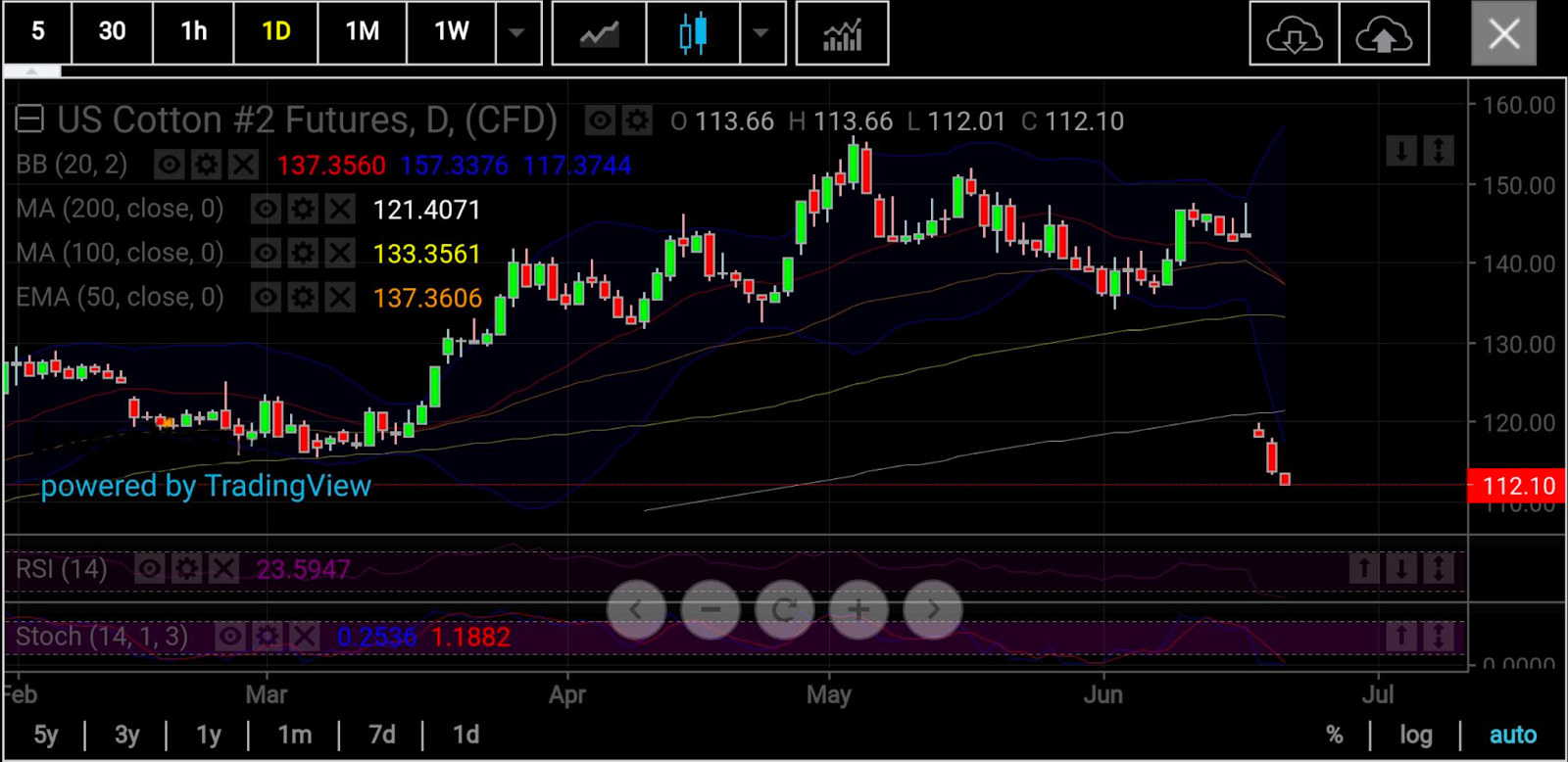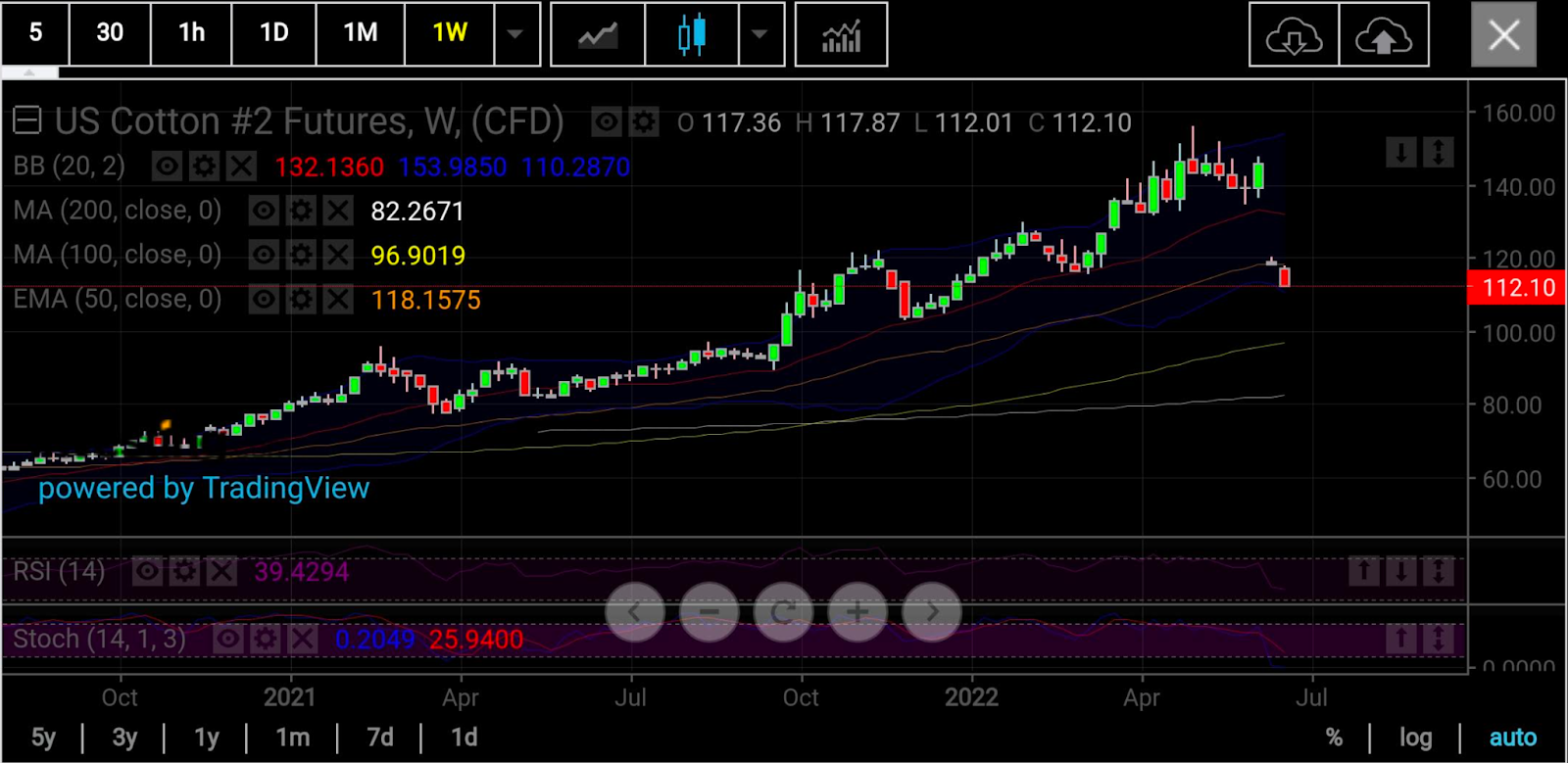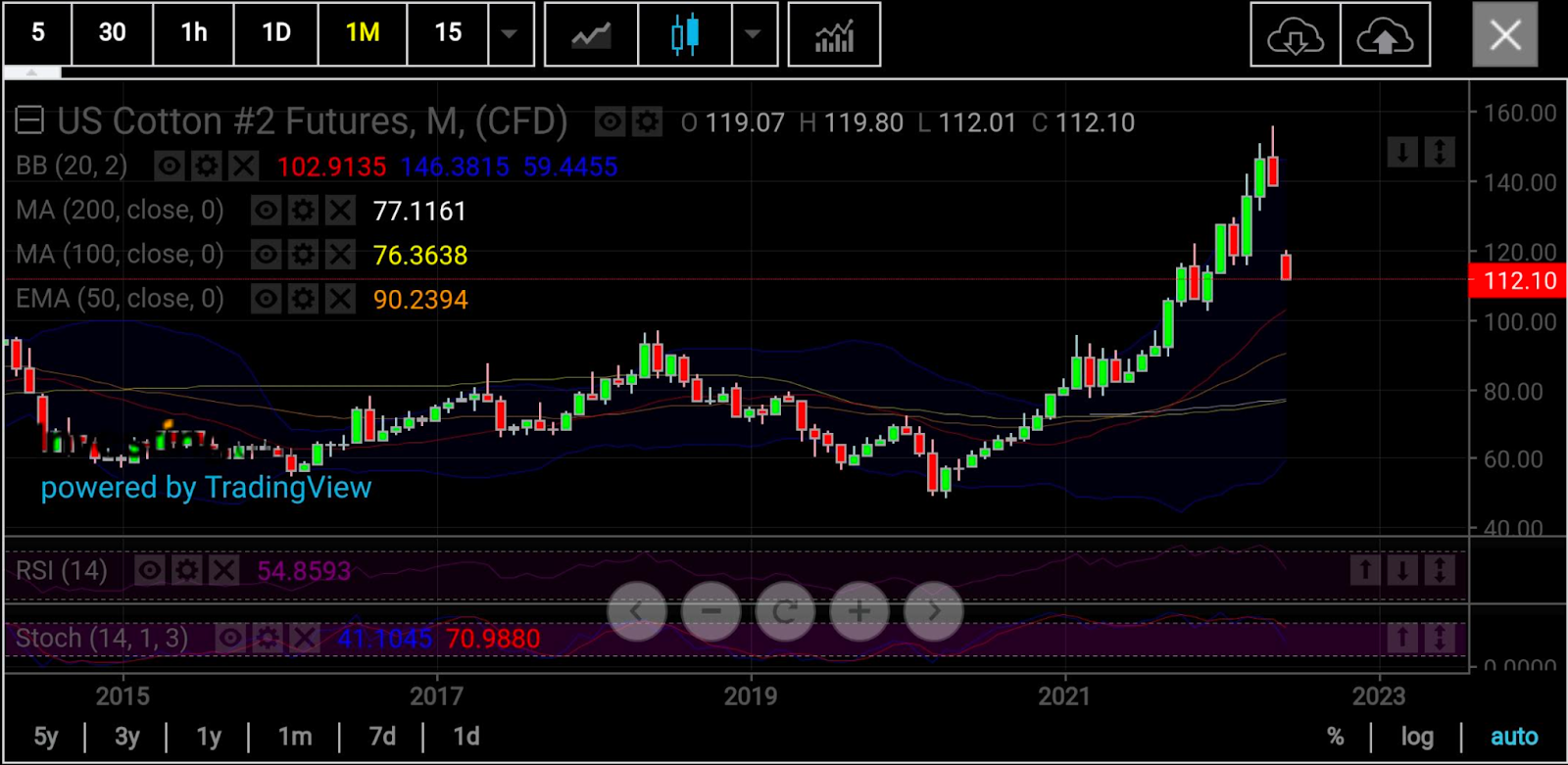Cotton has lost almost 25% of its value since the end of April, wiping out nearly everything it had gained from strong performances in three of the first four months of the year. Improving weather may be a factor. But the overwhelming reason is fear of a US recession, as this is one of the most vulnerable commodities in times of economic apprehension.
Usually when economists begin cautioning about a recession, one of the first impacts we see is a reduction in cotton consumption. The relationship is quite simple. When times are tough, clothing and furnishings become discretionary. People will put off buying new garments until times are better; corporations may delay refurbishments that include new rugs, drapes and fabric-based furniture. All these make cotton more sensitive to an economic slowdown than any agricultural commodity.
On Friday itself, cotton on ICE Futures US lost almost 18%, tumbling to a $1.1781 lb low last seen on Mar. 15. Prior to that, US cotton futures hit a near 11-year high of $1.5515 on Mar. 5, in response to Russia's war on Ukraine and the global raw materials supply squeeze and runaway inflation caused by that.

All charts by skcharting.com
Friday’s collapse in cotton came amid fears that the Federal Reserve might impose more super-sized rate hikes this year on the US economy after a three-quarter percentage point increase on June 15—its highest in 28 years—to battle inflation running at 40-year highs.
US gross domestic product already contracted 1.5% in the first quarter of this year. If the second quarter turns out to be negative as well, it will technically place the country in a recession, given that two straight negative quarters automatically qualify for such a status. There is widespread belief that the Fed will force the United States into a recession in its bid to bring inflation—measured by the Consumer Price Index at 8.6% a year in May—to the central bank’s target of 2% a year.
Fed Chair Jerome Powell denies the assertion that the central bank is out to induce an economic slowdown, although he admits that its target is to achieve a soft-landing for the economy when done with rate hikes, which he projects will go on until 2024. Few economists believe in the soft-landing.
“The Fed raised interest rates by 0.75% in an effort to control inflation and there has been talk that the Fed will raise them even more and cause lost economic opportunity and lost cotton business,” said Jack Scoville, chief crop analyst at Chicago’s Price Futures Group brokerage.
In 2020, fears of a long-lasting recession from the coronavirus pandemic took cotton futures down almost 28% in the first quarter, with the selloff beginning as early as January—even before the virus had spread across the world. Yet, cotton prices finished the year up more than 14%, rallying strongly from April onward as government aid relief programs provided a balm for the economy despite some 20 million Americans losing their jobs at the height of the COVID breakout.
Now, US jobs growth is at its strongest in history, with unemployment steadily at 3.6%—well below the Fed’s 4% minimum for “maximum employment” — for two months in a row in April and May.
Some say that could insulate cotton futures again in the coming months, despite the bleak immediate outlook for the crop.
In a recession, a cotton buyer sometimes has to discard 3% to 7% percent of the raw product and is unable to lock in on a price as the contents of the raw product are not uniform. That’s the inherent nature of cotton.
In contrast, cotton’s competitors—polyester and a number of other ‘non-natural’ fibers—don’t have that waste. They also have locked-in prices and a uniform raw product. But these fibers don’t have the many natural qualities of cotton.
About 85% of all the cotton grown in the world goes into the manufacture of clothing—by far the largest percentage. The biggest part of the clothing market is apparel.
On the positive side, increasing market share in women’s apparel has been a big emphasis for cotton in recent years. Cotton currently has about 50% of the market share in women’s and girls’ apparel.
In the United States, cotton is the primary fiber in 98% of jeans sold in the country. Cotton also makes up 86% of the weight of American knit shirts, 72% of t-shirts, 67% of slacks and 47% of dresses and skirts.
A big, and increasingly important market for cotton is also athletic sportswear. Surveys indicate more than 60% of people who buy athletic and recreational sportswear prefer cotton. Developing a product that has the softness and comfort qualities of cotton has been a challenge for the non-cotton industry. When it comes to athletic clothing, cotton’s thickness and moisture-absorbing qualities are tough for polyester and other alternatives to emulate.

So, how low could cotton technically go if recession fears continue to grip the United States?
“Charts indicate that the support level could go to 97 cents while the upside, in the event things swing back up, could reach even $1.44,” said Sunil Kumar Dixit, chief technical strategist at skcharting.com.
Dixit said cotton futures gapped down from $1.43 straight to $1.20, with the steep drop leaving the market extremely oversold on the daily and weekly charts of cotton.

The resultant stochastic readings of 0.25/1.18 and 0.20/26 from that plunge called for an imminent pullback from the lows, to fill the runaway gap of between $1.20 and $1.44, said Dixit.
In the event prices drop further, the monthly middle Bollinger Band of $1.03 and the 100-week Simple Moving Average of 97 cents could act as support, he said.
On the way up, the 50-week Exponential Moving Average of $1.18 can act as a minor resistance clearing, which cotton will face resistance at the 100-Day Simple Moving Average of $1.33 and the swing low of $1.34, said Dixit.
He added:
“The steep drop with a huge run away gap and any further correction towards $1.03 and 97 cents are likely to be used as value-buying opportunities for a long-term rebound, when prices reach above $1.20 and $1.34 to fill out the gap at $1.44.”
Disclaimer: Barani Krishnan uses a range of views outside his own to bring diversity to his analysis of any market. For neutrality, he sometimes presents contrarian views and market variables. He does not hold a position in the commodities and securities he writes about.
